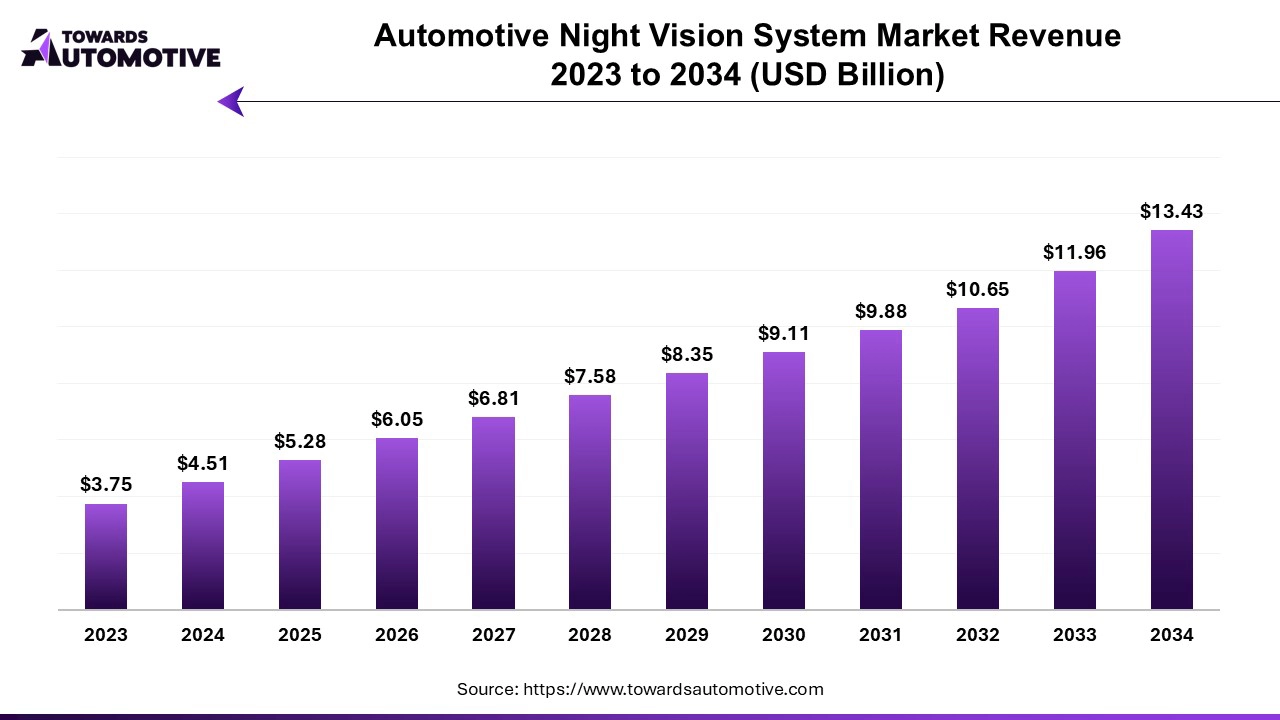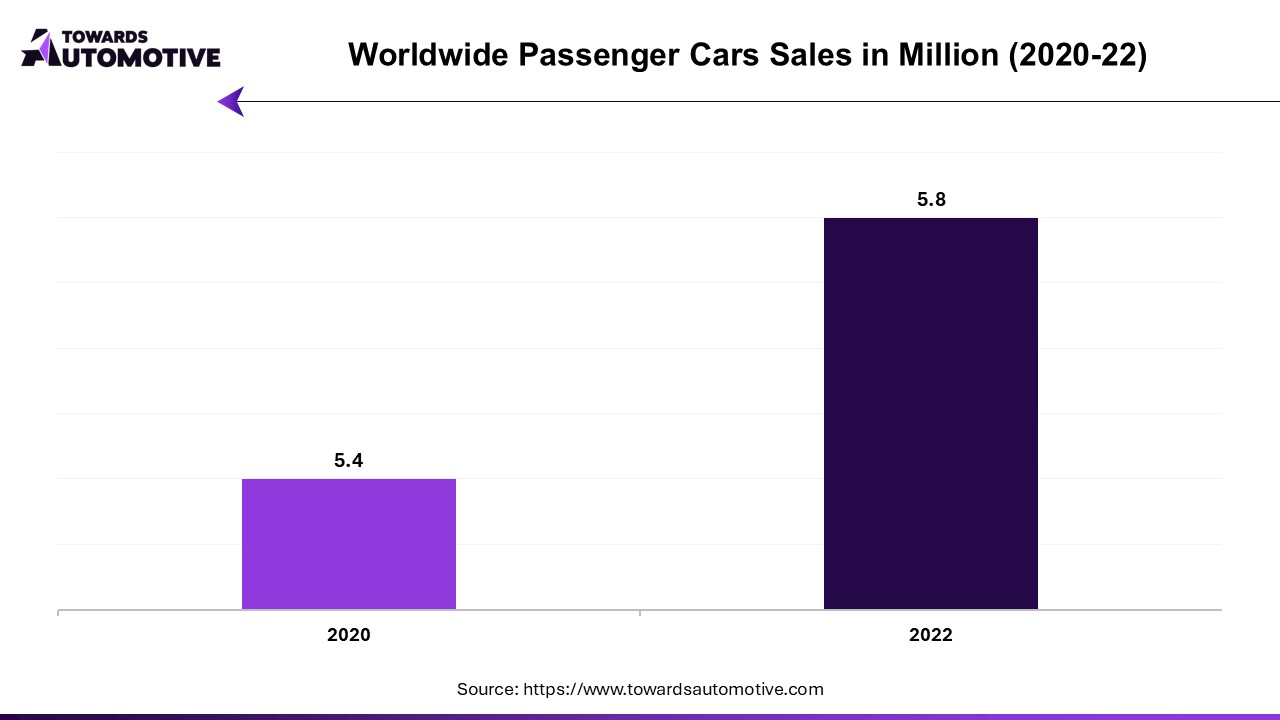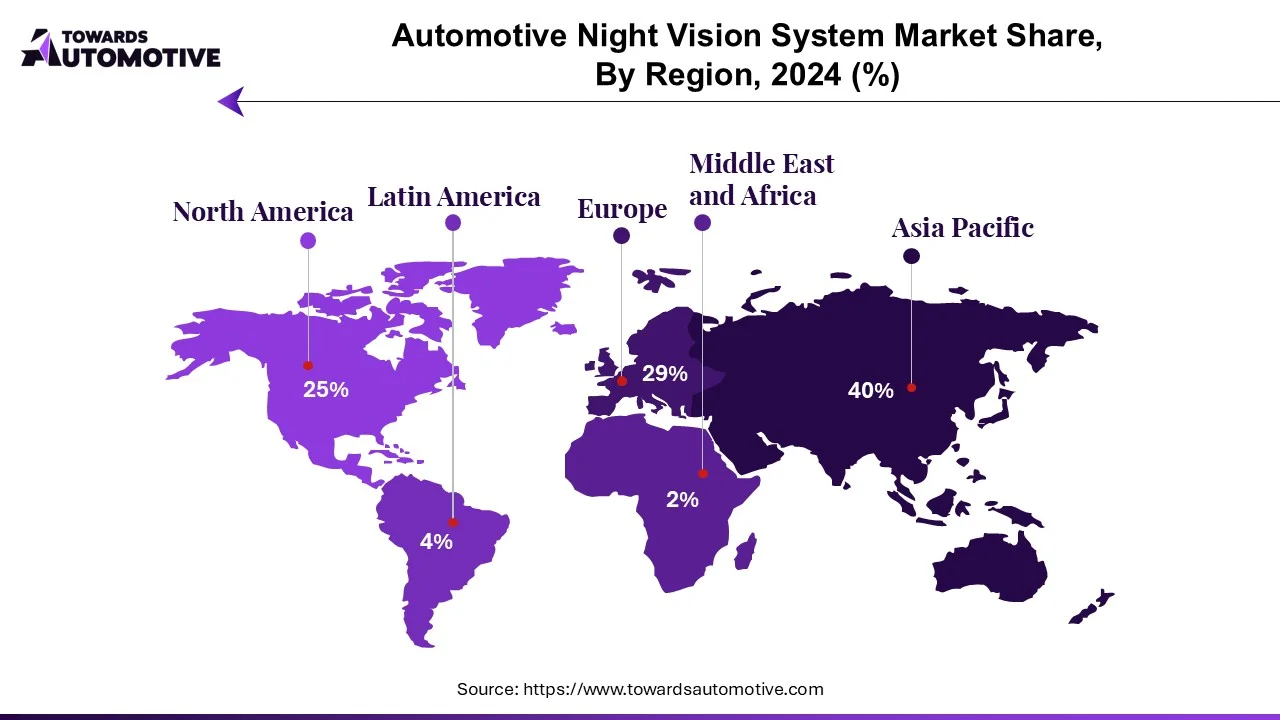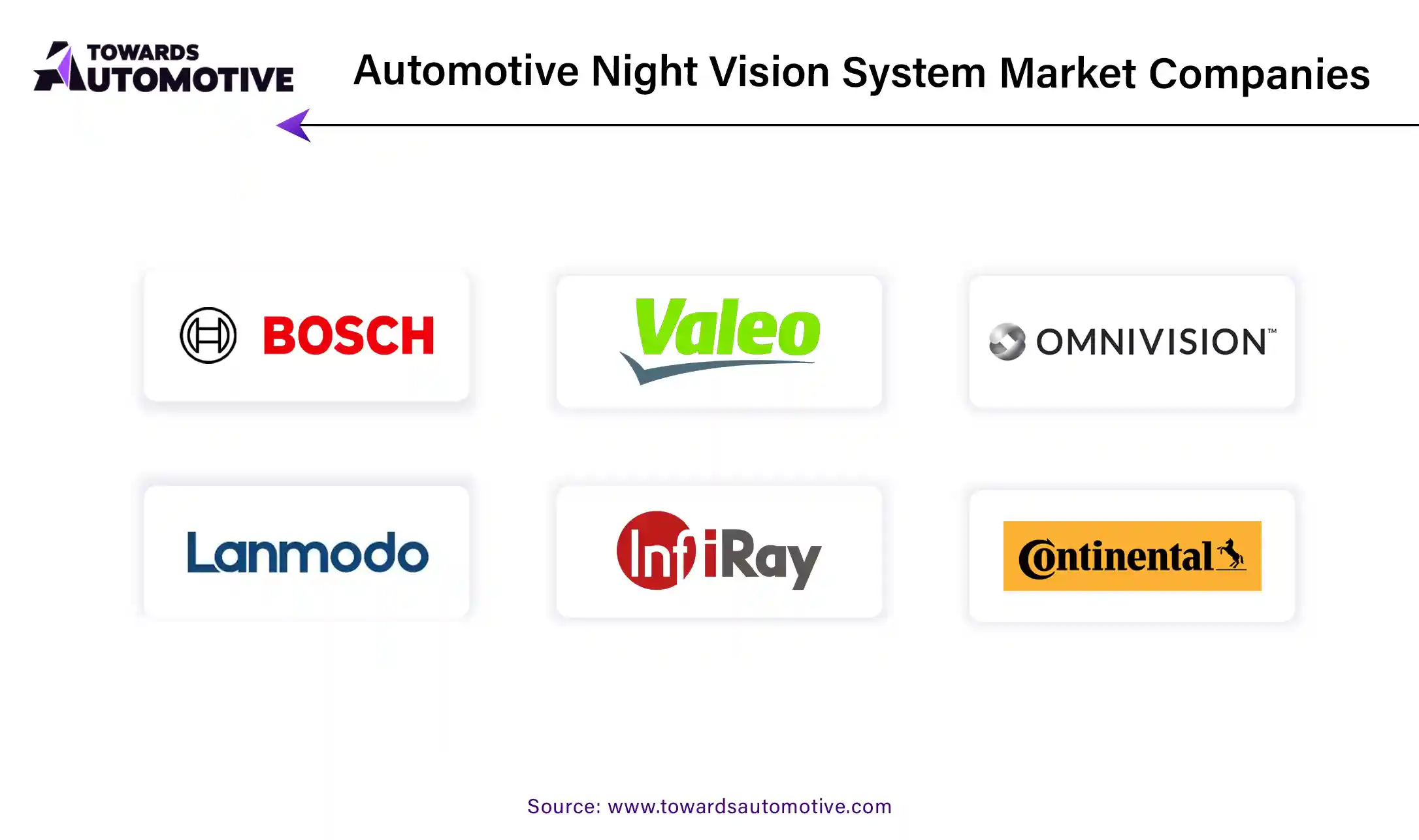April 2025
The global automotive night vision system market is forecast to grow at a CAGR of 12.3%, from USD 5.28 billion in 2025 to USD 13.43 billion by 2034, over the forecast period from 2025 to 2034.

Unlock Infinite Advantages: Subscribe to Annual Membership
The automotive night vision system market is experiencing significant growth, driven by the increasing demand for enhanced safety features and advanced driver-assistance systems (ADAS) in vehicles. Night vision systems utilize infrared technology to improve visibility in low-light conditions, enabling drivers to detect pedestrians, animals, and other obstacles that may not be visible through standard headlights. As safety regulations become more stringent and consumers become more aware of the importance of vehicle safety, automakers are increasingly integrating night vision systems into their new models.
Additionally, the growing trend towards luxury and high-end vehicles has contributed to the market's expansion, as manufacturers seek to offer advanced safety features that differentiate their products in a competitive landscape. Furthermore, the rising popularity of electric and autonomous vehicles has accelerated the development of innovative night vision technologies, which are essential for ensuring safe navigation in various driving conditions.
The integration of night vision systems with other advanced technologies, such as lane departure warning systems and adaptive cruise control, is also enhancing their effectiveness and appeal. As the automotive industry continues to prioritize safety and technological advancements, the automotive night vision system market is poised for substantial growth, driven by ongoing innovations and increasing consumer demand for safer driving experiences.
Artificial Intelligence (AI) plays a transformative role in the automotive night vision system market by enhancing the effectiveness and functionality of these systems. AI algorithms are increasingly being integrated into night vision technologies, enabling vehicles to process and analyze data from infrared cameras and sensors in real time. This advanced capability allows for the identification of pedestrians, animals, and other obstacles more accurately and swiftly, significantly improving driver awareness and safety during low-light conditions.
Moreover, AI enhances the ability of night vision systems to adapt to varying environmental factors, such as weather conditions and terrain types. Machine learning models can be trained to recognize patterns and distinguish between different objects, minimizing false alarms and ensuring that drivers receive relevant information only when necessary.
Additionally, AI can facilitate the integration of night vision systems with other advanced driver-assistance systems (ADAS), creating a cohesive safety network that supports functions like automatic braking and collision avoidance. As the demand for safer and more intelligent vehicles grows, the role of AI in the automotive night vision system market will likely expand, driving innovation and enhancing the overall driving experience. Ultimately, AI's contributions are pivotal in transforming night vision systems into indispensable components of modern automotive safety technology.
The increasing incidence of road accidents is a significant driver of growth in the automotive night vision system market, as both consumers and manufacturers seek enhanced safety solutions to mitigate risks associated with nighttime driving. According to statistics from various traffic safety organizations, a substantial percentage of fatal accidents occur during low-light conditions, where visibility is compromised. This alarming trend has prompted stakeholders in the automotive industry to prioritize the development and integration of advanced safety technologies, including night vision systems, into vehicles.
Night vision systems utilize infrared cameras to detect and display obstacles, pedestrians, and animals well beyond the reach of conventional headlights, providing drivers with greater situational awareness. As awareness of the safety benefits of these systems grows, more consumers are demanding vehicles equipped with such technologies, prompting automakers to invest in their development. Additionally, government regulations and safety initiatives aimed at reducing road accidents are encouraging the adoption of advanced driver-assistance systems (ADAS), of which night vision technology is a critical component.
In response to the rising concern over road safety, the automotive night vision system market is poised for significant growth, driven by the increasing demand for innovative solutions that enhance visibility and reduce the likelihood of accidents in challenging driving conditions.

The automotive night vision system market faces several restraints that could hinder its growth. One significant challenge is the high cost of night vision technology, which can make vehicles equipped with these systems less accessible to a broader consumer base. Additionally, the complexity of integrating night vision systems with existing vehicle architectures and advanced driver-assistance systems (ADAS) poses technical challenges for manufacturers. Moreover, the limited consumer awareness regarding the benefits of night vision technology may reduce demand, as many drivers may not recognize its potential to enhance safety. Finally, regulatory hurdles and varying standards across different markets can further complicate the adoption of these systems.
The integration of night vision systems with Advanced Driver-Assistance Systems (ADAS) is creating significant opportunities in the automotive night vision system market, driven by the increasing emphasis on vehicle safety and the demand for enhanced driving experiences. By combining night vision technology with ADAS functionalities, automakers can provide drivers with comprehensive support during low-light and challenging driving conditions. This integration enables features such as adaptive headlights that adjust brightness and direction based on detected obstacles, improving visibility and reducing glare for oncoming traffic.
Moreover, the synergy between night vision systems and ADAS facilitates advanced functionalities like automatic emergency braking and collision avoidance, which can identify potential hazards in real time and take corrective actions to prevent accidents. As consumers become more aware of the safety benefits associated with these integrated systems, the demand for vehicles equipped with such technologies is expected to rise.
Additionally, regulatory frameworks promoting safety standards are encouraging automakers to prioritize the development of integrated solutions that meet these requirements. This focus not only enhances vehicle safety but also provides a competitive edge in a rapidly evolving market. Overall, the integration of night vision systems with ADAS is paving the way for innovation, creating new opportunities for manufacturers, and significantly contributing to the growth of the automotive night vision system market.
The far infrared (FIR) segment held the largest share of the market. The far infrared (FIR) segment is a crucial driver of growth in the automotive night vision system market, primarily due to its ability to enhance visibility and safety in low-light driving conditions. FIR technology utilizes longer wavelengths of infrared radiation, enabling it to detect heat signatures from objects such as pedestrians, animals, and other vehicles that may not be visible with conventional lighting systems. This capability significantly improves situational awareness for drivers, especially in rural areas or poorly lit environments.
As FIR systems can operate effectively in various weather conditions, including fog, rain, and snow, they offer a reliable solution for enhancing nighttime safety. The increasing adoption of FIR technology in high-end and luxury vehicles is further propelling market growth, as manufacturers aim to differentiate their products through advanced safety features. Moreover, the integration of FIR night vision systems with advanced driver-assistance systems (ADAS) provides additional functionalities, such as collision avoidance and adaptive headlights, further driving consumer interest and demand.
As safety regulations become more stringent, the automotive industry is compelled to adopt innovative technologies, such as FIR, to meet these standards. Consequently, the far infrared segment is not only enhancing the effectiveness of night vision systems but also positioning itself as a key contributor to the overall growth of the automotive night vision system market.
The night vision camera segment led the industry. The night vision camera segment is a pivotal factor driving growth in the automotive night vision system market, primarily due to its advanced imaging capabilities that significantly enhance driver safety and awareness during nighttime driving. These cameras utilize either near-infrared or thermal imaging technology to capture clear visuals in low-light conditions, allowing drivers to detect pedestrians, animals, and other vehicles that would otherwise be difficult to see. As a result, night vision cameras play a crucial role in reducing the risk of accidents, particularly in rural or poorly lit areas.
The growing emphasis on safety features in modern vehicles has led manufacturers to incorporate night vision cameras as standard or optional equipment, particularly in premium and luxury models. Additionally, advancements in camera technology, such as higher resolution and improved sensitivity, have made these systems more effective and appealing to consumers. The integration of night vision cameras with advanced driver-assistance systems (ADAS) further enhances their functionality, enabling features like collision warning and automatic braking, which bolster overall vehicle safety.
As consumers increasingly prioritize safety in their purchasing decisions, the demand for vehicles equipped with night vision camera systems is expected to rise. Consequently, this segment is poised for significant growth, propelling the overall expansion of the automotive night vision system market.
The passenger vehicles segment held a dominant share of the market. The passenger vehicles segment plays a vital role in driving the growth of the automotive night vision system market, largely fueled by the increasing consumer demand for enhanced safety features and advanced technologies in everyday cars. As concerns about nighttime driving hazards rise, automakers are incorporating night vision systems into their passenger vehicle offerings to improve visibility and minimize the risk of accidents. These systems utilize infrared and thermal imaging technologies to detect and highlight obstacles, pedestrians, and animals well beyond the reach of standard headlights, thereby providing drivers with greater situational awareness.
Moreover, the growing trend toward smart and connected vehicles is facilitating the integration of night vision systems with other advanced driver-assistance systems (ADAS). This combination not only enhances safety but also improves the overall driving experience by offering features like automatic emergency braking and adaptive lighting. Additionally, the increasing prevalence of luxury features in mid-range passenger vehicles is expanding the market for night vision systems beyond high-end models, making them more accessible to a broader consumer base.
As safety regulations continue to tighten and consumer preferences evolve, the passenger vehicle segment is poised for substantial growth in the automotive night vision system market. This trend underscores the importance of innovative safety technologies in enhancing the appeal of modern vehicles while prioritizing driver and passenger safety.


North America dominated the automotive night vision system market. In North America, the automotive night vision system market is experiencing substantial growth, driven by increasing road safety concerns, the rising adoption of electric vehicles (EVs), and the expanding luxury vehicle market. Heightened awareness of road safety issues has prompted consumers and manufacturers to prioritize advanced safety technologies, including night vision systems, which significantly enhance visibility during nighttime driving. These systems enable drivers to detect potential hazards, such as pedestrians and animals, that may not be visible with standard headlights, thereby reducing the risk of accidents.
Moreover, the rising adoption of EVs is contributing to the market's growth, as these vehicles often come equipped with cutting-edge technology aimed at improving safety and performance. Many EV manufacturers are incorporating night vision systems into their models as part of their commitment to innovation and driver assistance features.
Additionally, the growing luxury vehicle market in North America is further propelling the demand for night vision systems. Luxury car buyers increasingly expect advanced safety features as standard or optional equipment, and night vision technology is viewed as a premium enhancement.
Asia Pacific is expected to grow with the highest CAGR during the forecast period. Urbanization, the demand for safety features, and the growth of vehicle ownership are significant drivers of the automotive night vision system market in the Asia-Pacific (APAC) region. Rapid urbanization across APAC countries is leading to an increase in vehicle traffic, particularly in densely populated cities. This surge in traffic heightens the risk of accidents, especially during nighttime when visibility is often compromised. As a result, consumers and manufacturers are increasingly prioritizing advanced safety technologies, including night vision systems, to enhance visibility and mitigate risks associated with nighttime driving.
Additionally, rising consumer awareness of road safety is fueling the demand for safety features in vehicles. Night vision systems, which allow drivers to detect obstacles and pedestrians beyond the reach of standard headlights, are becoming essential for those who prioritize safety. Manufacturers are responding to this demand by integrating these systems into their vehicles as standard or optional features.
Furthermore, the growth of vehicle ownership in APAC, driven by rising disposable incomes and a growing middle class, is creating a larger market for automotive technologies. As more consumers invest in vehicles, the expectation for enhanced safety features, including night vision systems, is increasing.

By Technology
By Component
By Vehicle
By Region
April 2025
April 2025
April 2025
April 2025
We offer automotive expertise for market projections and customizable research, adaptable to diverse strategic approaches.
Contact Us